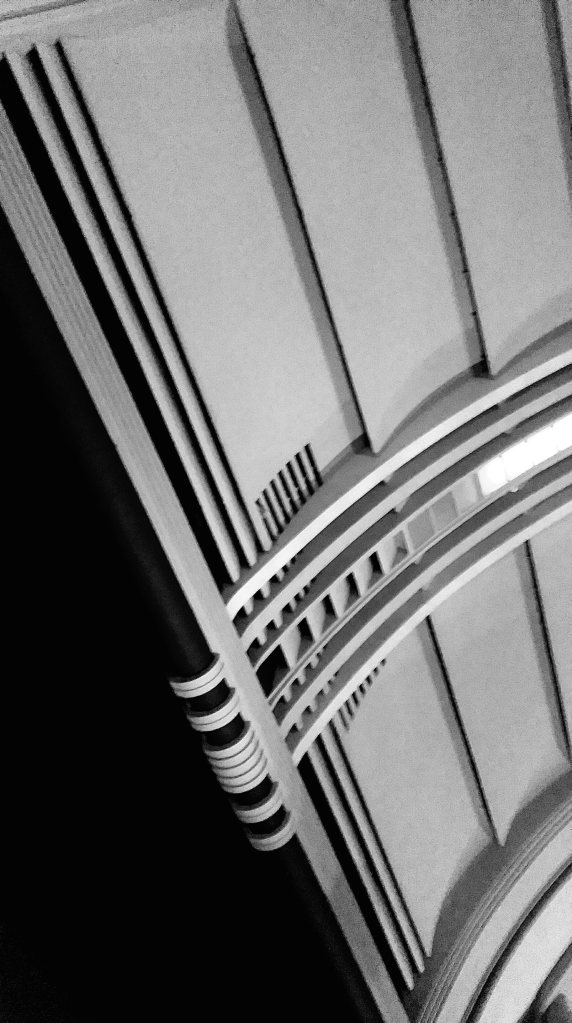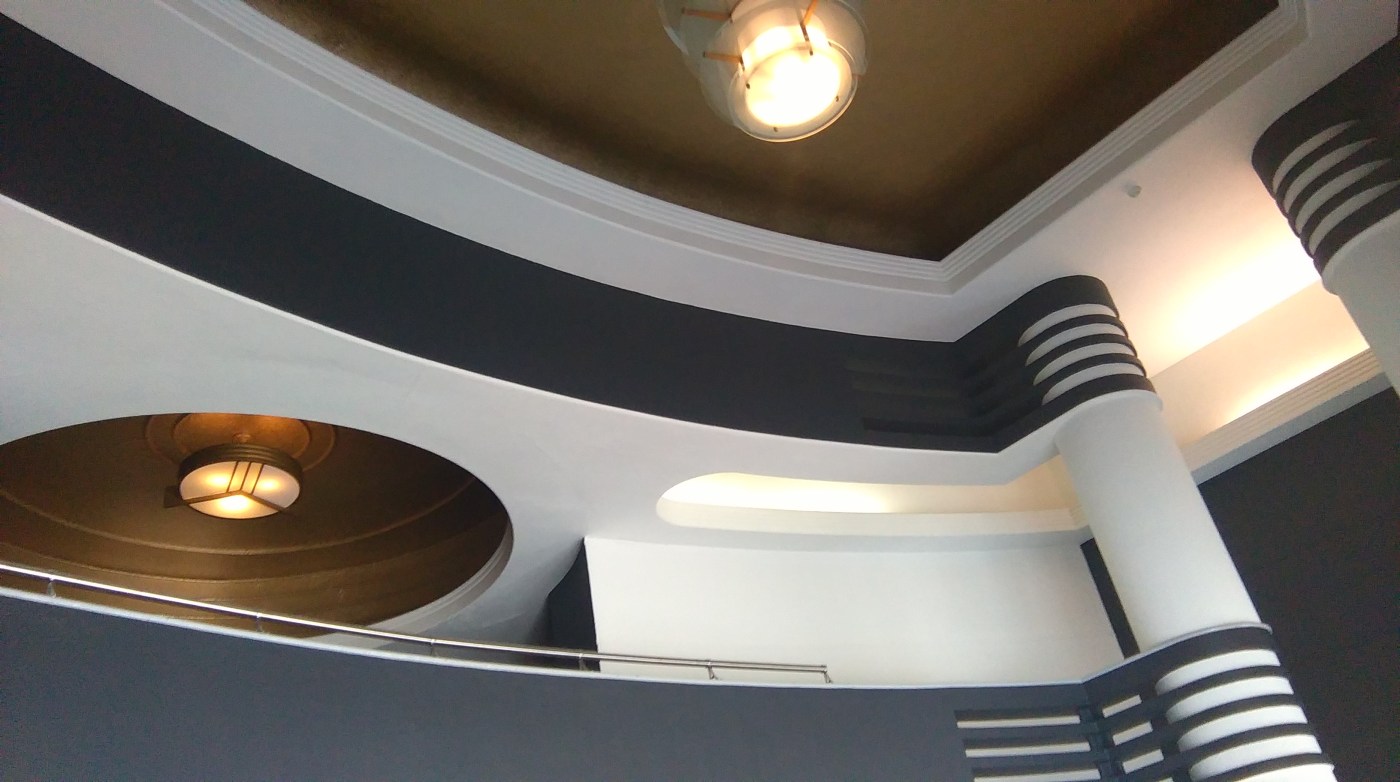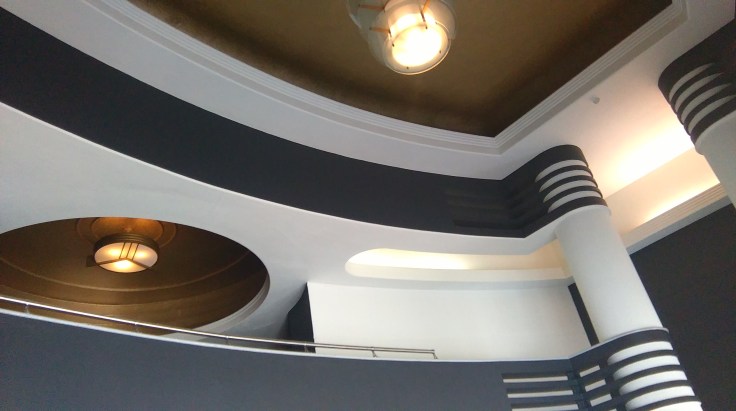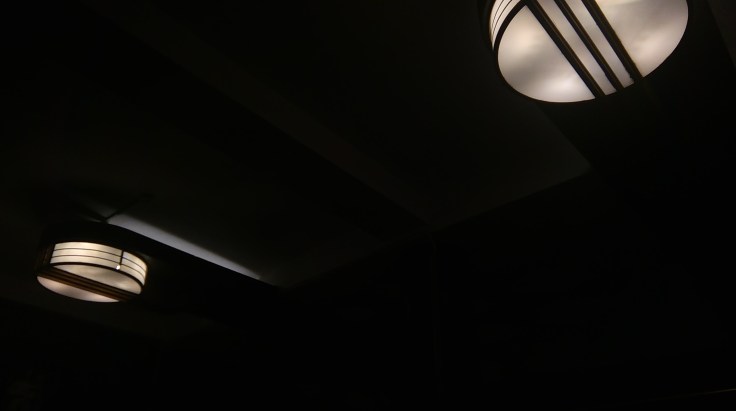Where better to begin than in one’s own back garden?
Muswell Hill is blessed with several fine examples of 1930s architecture and since perhaps the finest of these, George Coles’ Odeon Cinema (1935-6), is currently being restored we were keen to take a look and see how things are progressing.

The restoration of Coles’ cinema by Everyman takes place within the wider context of the works being carried out to revitalise and expand the neighbouring ‘Odeon Parade’ (also by Coles) which has seen a significant expansion of both its buildings and the surrounding pedestrianized area. The hope is to create a ‘piazza’ style focal point at the west end of the Broadway. Local opinion seems mixed as to the loss of the Odeon brand, particulary since the cinema has been a regular feature of Muswell Hill life for 80 years, yet most are happy to see the beautiful Grade II* listed expressionist style building finally being given the attention it deserves.
The cinema has the most elaborate interior of any surviving Odeon. Company boss Oscar Deutsch faced significant local opposition to the building of a cinema on the site, not least from the church authorities who have historically dominated the area. A compromise was acheived whereby the entrance was moved away from the corner and height restrictions were put in place on the façade. The latter resulted in a budget surplus and it was decided to spend these funds on upgrading the interior instead. Eventually this led to the creation of what Historic England describe as “an elegant design of unusual imagination and crispness” realised in a style which Pevsner dubbed ‘minimalist streamlined’. Deutsch appears to have been flexible enough in his business planning to allow for local demographics; here he decided that the area’s predominantly middle-class residents were broad-minded enough to accept a continental style cinema in the midst of the Edwardian architectural pomp which characterises N10, and sufficiently affluent to support the presumably higher than average ticket prices. The listing entry goes on to say that the building, “best demonstrates the influence of German expressionism in British cinema design. As all the most famous German models have been gutted or demolished, the English examples are particularly important.” It was to be the fifth Odeon cinema designed by Coles and is widely regarded as his best.
On entering the cinema one is immediately captivated by the ebullient style of the double-height lobby, dominated on either sie by banded columns reminiscent of the futuristic film sets of the silent era such as Fritz Lang’s Metropolis. One can almost imagine electricity arcing and crackling over them. The ceiling is also very fine and after admiring the well-preserved circular light fixtures one’s eyes are drawn down to what is by far the most exciting revelation of the restoration project thus far – the uncovering of the original lobby floor. This features a beautiful and surprisingly colourful geometric pattern in the manner of László Moholy-Nagy; we say surprisingly colourful because previously we have only seen black and white photos of the original lobby and though we assumed it was certainly bright we weren’t quite expecting the striking combination of coral pink, greys, green and yellow which has been revealed.

Everyman have said of the project, “We’re working on a new look. Some things will change quickly, others will take longer.” We assume this to mean that they decided against a long closure for refurbishment and opted instead to fit work around the continued screening of films. This approach is eminently sensible yet naturally results in hasty work which may require some finessing later. The fresh paint work in the lobby is in parts of poor quality with the grey banding visibly bleeding over into the white in some areas and will hopefully be retouched at some point. Someone with more knowledge might tell us whether the textured surface applied to the walls throughout is ‘artexing’ added at a later date or is original; for now we assume it was applied post-war to mask cracks in the original smooth plaster.

The corporate Odeon carpeting has been removed from all rooms; in the lobby this has yielded the fine original flooring but in the bar area on the 1st floor (originally a tea room) it has left exposed the concrete sub-floor. Evidence of carpet adhesive is unfortunately clearly visible in the lobby but can hopefully be removed without incurring damage; for now a sticky yellow-brown trail can been be seen looping and snaking across the floor [update, March 2016 – the adhesive has been successfully removed]. The bar area is rather dark and curiously uninviting despite the scattered bean bags and vintage furniture; it is hoped that when finished it will be further improved and provide Muswell Hill with a much needed bar of quality and aesthetic appeal.

But what of the three auditoria? Alas, we have yet to see a film here. Hopefully a work sufficiently glum and obscure for our tastes will soon be shown, at which point we will be happy to report further. In the meantime here is a photo of the main auditorium showing the ceiling, styled to suggest a roll of film, descending gracefully to the proscenium below.

References:
Historic England, www.historicengland.org.uk
Cherry and Pevsner, London 4: North, Yale University Press, pgs 69, 566
Update: 11-4-2016

Renovation work to the lobby, café, bar and screens 2 and 3 is now complete. Finishes have been improved throughout and the furniture upgraded, and while we would have preferred to see tubular steel over the mid-century style chosen, the quality cannot be faulted. The café and bar (the latter opens only during the evenings) are both well worth visiting regardless of whether you are seeing a film. To sit and relax in Coles’ wonderful theatre is a pleasure indeed.

The final stage of work is an ambitious plan to remodel screen 1 (the main screen). This will see the insertion of two large ‘pods’ into the upstairs balcony area and the re-opening of the ground floor seating area for the first time since access was blocked in the 1970s (by the insertion of screens 2 and 3 beneath the balcony). The pods will create two more screens, but from the artist’s impression we have seen we find them to be ugly and rather intrusive. However, since they do not constitute permanent a change to the fabric of the building we are happy with the compromise.

© Modernist Tourists 2016






May 19, 2016 at 1:43 pm
We are restoring the art deco Llanelli Odeon which opened in 1938 and I can say that the textured coating was indeed original. Far from trying to cover up cracks, it was sprayed on after the walls and ceilings were smooth plastered as a very definite design choice.
Bands of smooth plaster were left exposed and painted with reflective gold or copper paint. This was to break up the textured coating into bands that received different colour treatments. The idea was to move away from plain, flat walls. Having a texture, coupled with a base colour, then flicked on dots of a much darker colour, and finally reflective gold dots, enabled the walls to have a mettalic 3d effect under Odeon lighting schemes. Lower bands were invariably shades darker. The textured and also with us combed walls were never designed to be a flat, single colour.
LikeLike
June 1, 2016 at 3:33 pm
Thank you very much for the information. The restoration of the Odeon in Muswell Hill continues and it is good to see that Everyman have successfully removed the carpet adhesive from the floor in the lobby and further developed the upper bar area. They are now moving on to ambitious plans to fit some rather unusual ‘pods’ within the main screen auditorium in order to add extra smaller screens. Do you have a website at this point for your re-launch?
LikeLike
June 5, 2016 at 12:38 am
If you are on Facebook please look up ‘Save The Old Llanelli Odeon’ It has more up to date information than our website which is http://www.calonlive.com
The Llanelli Odeon is a real modernist beauty!
Regards,
William
LikeLike